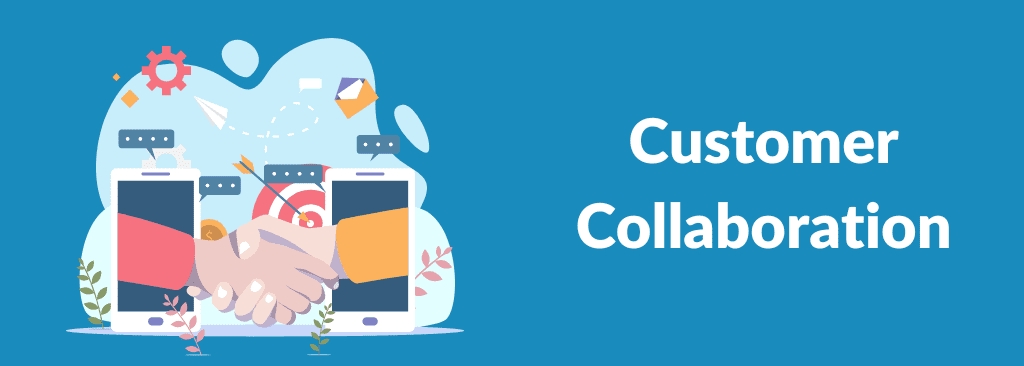What Is Customer Collaboration, and Why Is It Important?
Today’s customers expect more.
The expectations are personalization, convenience, choices, flexibility, reliability, and quality.
Besides, they expect empathy.
According to Salesforce, 66% of customers expect companies to understand their needs and expectations, and 68% expect brands to demonstrate empathy in customer service.
In essence, customers want to be at the center of your universe, and rightly so.
Such a change requires a customer-centric mindset, not just improved communication, and service.
How Do You Get to a Customer-Centric Mindset?
The easiest way is through customer collaboration. I have greatly advocated co-creating with our customers to make them successful.
According to our experience, whenever we co-created with our customers, our relationship became more robust compared to other customers.
This invariably results in added business and customer loyalty.
Let us take a moment to define what is customer collaboration.
What Is Customer Collaboration?
Customer collaboration is about keeping your customers success at the center of everything you do. It is the partnership you stitch together with your customers and make them successful.
How do you make them successful?
Keep these in mind while collaborating with your customers:
- What are your customer’s goals?
- What is stopping them from achieving their goals?
- Does your offering solve their challenges?
- What will success look like when you solve their problems?
- How would the customer define value?
The operative word is the ‘value’ that you offer.
Let me give you an example.
Example of Customer Collaboration
We attended a collections event recently and met with a mid-sized organization’s CEO. He invited us to his office the next day to demonstrate our platform and how it could help them.
We understood there was resistance at the managerial level, as they were happy with the status quo. We were accommodated only because the CEO invited us.
We went there and had a long conversation with their CEO to understand the challenges stopping him from achieving his goals.
We showed them how our call center platform could help them remove all those challenges and the additional value it could bring to their business.
By the time we finished the demo, the manager was also on our side, as he was mightily impressed with how our platform could help their business.
We only showed the value and put together a POC based on those challenges and values.
They ended up signing with us for the value our platform provided despite our premium pricing.
Importance of Customer Collaboration
In the mid to late 80s, the outsourcing wave started worldwide. However, only the US market made it work, and the rest of the world was skeptical for a long time.
Why did it work for the US?
They are the only country that understood the outsourcing relationship as a partnership, not a customer and vendor relationship.
They invested substantial time in making the relationship work and enjoyed the benefits.
The rest of the world followed the US model many years later.
Likewise, in customer collaboration, you partner with your customers. Their success becomes your success, and everything you do is centered around them.
You go on a mission with joint ownership to figure out a path to success. This solidifies the relationship and makes your sales process quicker.
When the professional services team picks up the implementation after the pre-sale promises, there will be several questions and uncertainties on both sides.
You discuss those questions and uncertainties head-on, iron them out together, and find solutions to critical business challenges for your customers.
According to Gartner, the total number of business-to-business digital commerce transactions is expected to overtake the total number of B2B direct sales transactions, and by 2025, 80% of sales interactions between suppliers and buyers will occur in digital channels. To optimize the sales process through these changes, B2B organizations will implement digital sales rooms that blend the physical and digital sales experiences and allow customers and salespersons to collaborate.
Relationship Between Customer Collaboration and Co-creation
Let us come back to my pet peeve, which is co-creation.
What is Co-creation?
Co-creation is the process of collaborating with your customers in an ideation process to get fresh ideas, solutions, or customer input.
Let me give you some popular example of co-creation
- LEGO used this approach to great effect by launching LEGO Ideas. Since then, they have received over 1 million suggestions, with fans upvoting the most popular ideas.
- Miro created Miroverse, where Miro users come together to share designs and templates that are then made public for everyone to use.
- IKEA launched ‘Co-create IKEA’ in 2018, where they encourage customers and fans to develop new products. This has led to many thousands of customers’ suggestions.
- DeWalt, one of the leading manufacturers of power tools, established an Insight Community for its customers to contribute product ideas. It has grown to include more than 12000 people, who have helped DeWalt save over $6 million in research costs.
While the brands drive all of these co-creation ideas, the community contributions come from their challenges.
Essentially, the brand and the customers collaborate to remove the challenges customers face and become successful.
58% of businesses are now piloting co-creation projects to help drive innovation.
This collaboration can be a new way to discover market opportunities, push product branding in new directions, or establish a presence in a new area.
However, this isn’t easy.
It takes a lot of planning and foresight, as the customer has to perceive this as essential for their business as well.
